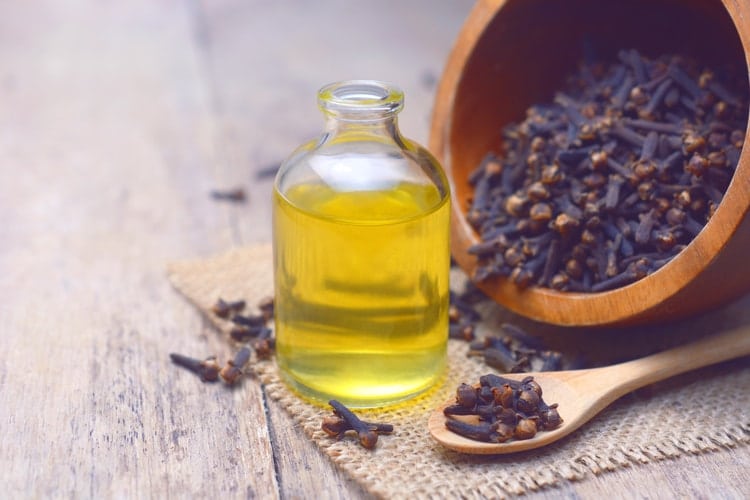
With up to 84% of women reporting that they experience menstrual cramps, it’s no wonder many of us have a love-hate relationship with our cycles.
And while this monthly cycle of pain is very common, you don’t have to buy into the idea that “coping” is your only option.
There are home remedies for menstrual cramps that provide relief and most importantly, help you to get your life back every month.
Of course, how well each remedy works varies based on the intensity of pain, whether the pain is also accompanied by heavy bleeding, nausea or other symptoms…plus your body’s unique needs!
So, as you go through this list of remedies, remember that they’re just a starting point. A customized, holistic care plan is what will ultimately help you address the root cause of any menstrual discomfort and irregularities.
Now, let’s dive in!
Note: this post contains some affiliate links and I earn a commission (at no additional cost to you) if you use them to make a purchase.
WHAT CAUSES PAINFUL MENSTRUATION?
Research suggests that hormones known as prostaglandins are most likely responsible for menstrual pain. These prostaglandins are fat-based hormones that help the uterus contract (source). These contractions are necessary in order for the uterine lining to be expelled from the body each month (as well as during childbirth).
However, if the body produces too much prostaglandins, then this can have a pro-inflammatory effect, resulting in pain.
But what would cause the body to produce excess prostaglandins in the first place? Well, it’s likely a result of inflammation (which can be caused by physical, chemical or emotional stress).
The good news is that you can influence inflammation and the remedies in this guide will help you do that.
So, without further delay, let’s have a look at these natural remedies for painful periods.
WHAT HOME REMEDIES HELP MENSTRUAL CRAMPS?
1. Essential Oils
One thing that essential oils do quite well is providing quick pain relief. While they may not necessarily get rid of cramps for good, the right ones can help you get through that time of the month more comfortably.
Some oils to try for menstrual cramps include:
- Clary sage – this guide gives you more details on why it may help cramps and hormone balance.
- Peppermint – learn more about it in this article.
- Marjoram.
- Eucalyptus – learn more about this oil here.
- Chamomile – get more information about this oil here.
- Lavender.
- Cypress oil – it promotes blood clotting and may also help with a heavy flow as discussed in this guide.
- Frankincense: one of the best anti-inflammatory oils. Learn more about it here.
- Clove oil – potent pain-reliever. Should generally be used in small amounts. Get more info about it here.
- Basil oil – it might leave you smelling a little like pizza, but it’s a good anti-inflammatory. Learn more here.
- Copaiba – check out this guide for more about this oil.
Aside from the above, a 2012 study found that a self massage with lavender, clary sage and marjoram essential oils reduces the duration of period pain from 2.4 days to 1.8 days.
The study used a 2:1:1 ratio of lavender, clary sage and marjoram oils, in a 3% dilution.
I’ve gone ahead and put together the recipe for you so that you can use it whenever you need it!
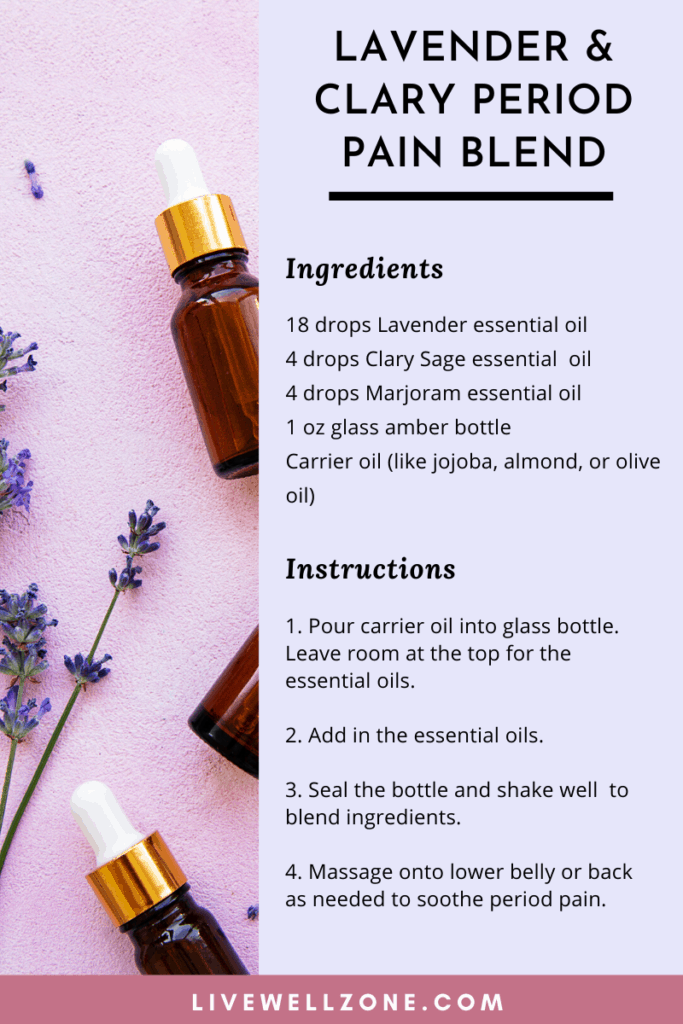
The essential oils used in the study contain compounds that are known for helping with pain and inflammation, including:
- Linalyl acetate
- Linalool
- Eucalyptol
- Beta‐caryophyllene
It is worth noting that the last ingredient in the list, beta‐caryophyllene, is a natural pain reliever that is also found in oils like clove, black pepper, hemp and copaiba oil.
There’s a lot of buzz about the pain-relieving properties of beta-caryophyllene and it’s worth trying for menstrual cramps.
To get you started, I’ve put together another menstrual cramp blend using clove, copaiba, frankincense and lavender oils.
This recipe also uses a 3% dilution. (NOTE: this recipe was updated on August 2022).
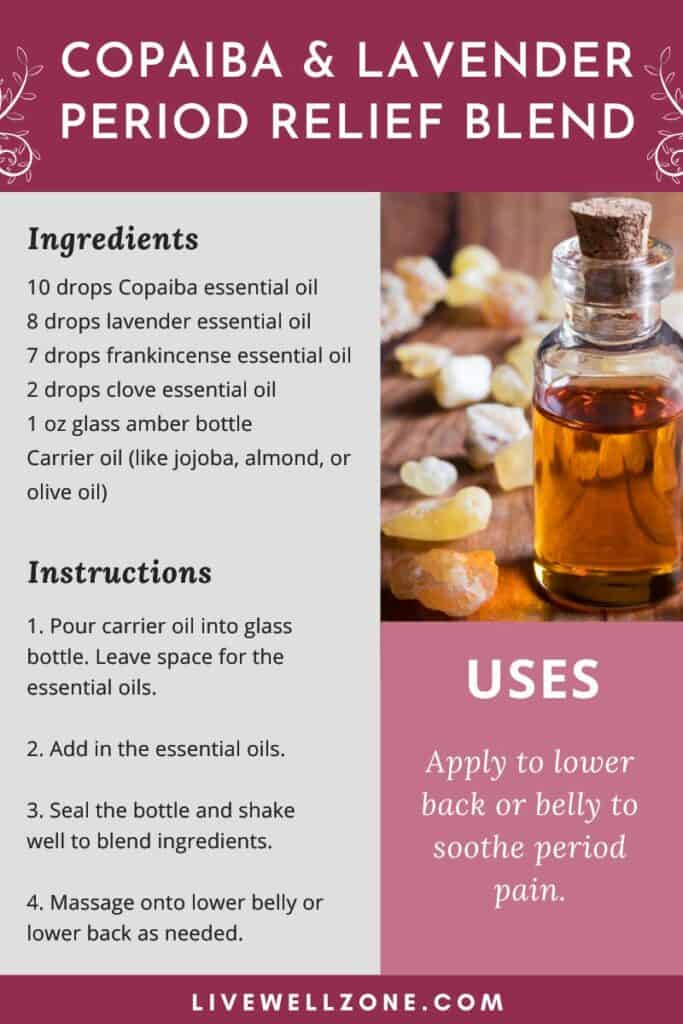
Don’t want to make your own blend? Try this PMS Ease blend. It comes in a ready-to-use roll bottle and features oils like lavender, clary sage and copaiba.
2. Multivitamins
There are several nutrients that can potentially help with menstrual cramps, such as
- Magnesium: has been shown to reduce prostaglandin production and improve cramps. It is estimated that 2 out of 3 people in developed countries are magnesium deficient (1, 2, 3). A simple way to get more magnesium is with a supplement or a spray like this one. In addition, a food like blackstrap molasses is a good source of magnesium and iron (which can be helpful if you also have a heavy flow). This guide on blackstrap molasses for heavy periods gives you more details.
- Vitamin K: research suggests that vitamin K1 injections may help to lower menstrual cramping. In addition, vitamin K is essential for blood clotting and a deficiency in this nutrient may play in role in heavy periods (learn more about this here)
- Vitamin E: as an antioxidant, vitamin E can reduce phospholipid peroxidation (a process in which free radicals attack specific lipids in the body). By reducing this process, this also stops the production of arachidonic acid, which is a precursor to prostaglandins (6, 7).
Keep in mind that these are just a few of the nutrients that the body uses to reduce pain and inflammation. Other nutrients that play a role in inflammation include vitamin B1, vitamin C, omega-3 fatty acids and more.
So, to ensure that you’re covering all your nutritional needs, it’s often easier to take one, good quality daily multivitamin.
This way you don’t have to buy multiple individual supplements, take lots of pills or worry about how to dose each of them appropriately.
The two multi-vitamins that I personally like are Beyond Tangy Tangerine 2.0 and Multi-Vita-Min. Both are food-based but the first is much more complete (and a little pricier), while the second is cheaper but doesn’t give you nearly as many nutrients.
3. Heating Pads
The main reason why heat can soothe pain is that it increases circulation.
In fact, a small study done with women experiencing menstrual pain showed that a heating pad (made with iron chip) and ibuprofen had comparable pain-reducing effects (source).
Another study showed that using heat pads set to 104 – 107°F produced the following results (source):
- 27% pain reduction after one hour.
- 43% pain reduction after two hours.
- 79% pain reduction after four hours.
Now, when it comes to the types of heating pad to use, there are a couple of options to choose from:
- Rael Herbal Heat Patch: These discreet, adhesive patches can be placed on top of your undies, giving you relief as you go about your day. They’re infused with essential oils of rose, lemon and jasmine oil. In addition, the heat is activated once you open the patch and it comes into contact with air. Very practical! Get the Rael Heat Patch here.
- Electric Heating Pad: This extra large pad comes with an automatic shut off option (so if you fall asleep while using it, you won’t have to worry about overheating your skin). It’s made from a soft, plush fabric and is machine washable. Includes a 10-foot long cord. Get this electric heating pad here.
4. Light and Gentle Exercise
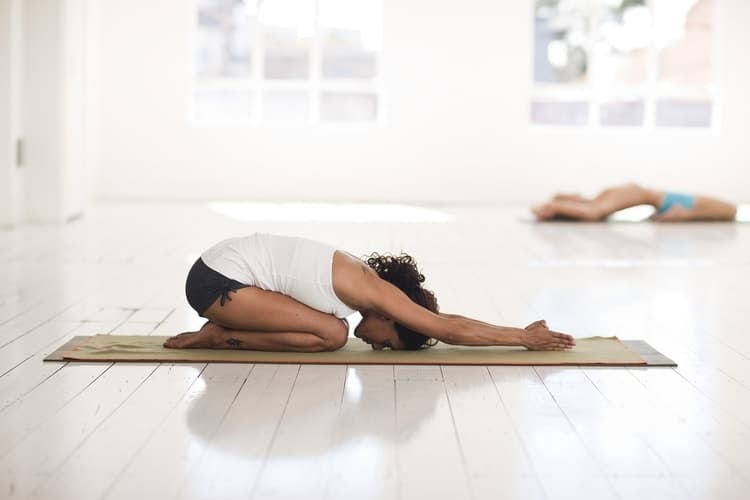
Although exercise might be the last thing you want to do when you have cramps, it’s actually one of the best ways to soothe period pain.
That’s because exercise releases hormones known as endorphins.
These endorphins give us an all-around feel-good sensation.
Endorphins also interact with pain receptors in the brain, therefore reducing our perception of pain.
Now, when it comes to exercising during your period, it’s important to do light activities.
Yoga is my favorite form of exercise for that time of the month (I know, shocking that a yoga teacher enjoys doing yoga!).
But seriously, setting my aside my personal bias, you’re better off doing low intensity activities during your period.
The reason for this is that low intensity activities put less stress on the body.
High intensity activities, on the other hand, can worsen pain because they put added stress on the body. You really don’t need more of that!
5. Slow, Deep Breathing
Have you considered slow, deep breathing as a natural remedy for cramps?
It’s a small practice that can make a huge difference.
Slow deep breathing refers to breathing with the belly and diaphragm.
Simply put, it means you allow your belly to expand when you inhale, and then you relax the belly toward the spine on the exhale.
When this type of breathing is done slowly, it triggers the nervous system to calm down, ultimately reducing the intensity of pain.
To get stared, try this simple demo from Yoga with Adriene, where she uses deep breathing with the ujayi breathing technique.
Ujayi is a unique breathing method that creates a deeper sense of relaxation.
Give it a try 🙂
6. Anti-Inflammatory Herbs and Tea
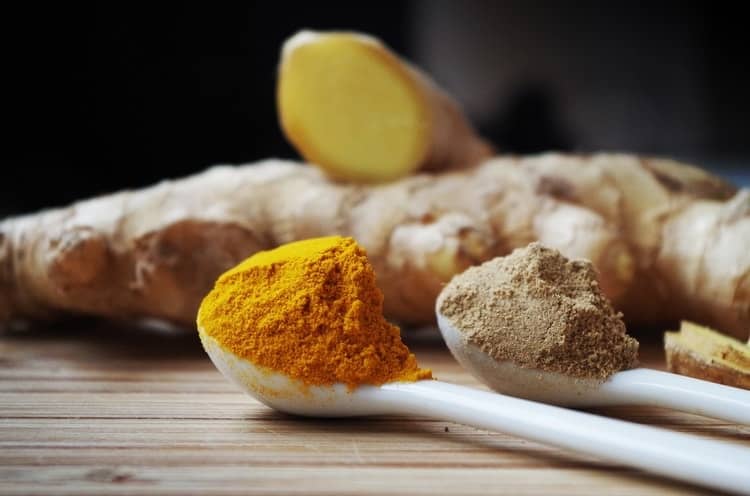
Cramp bark, ginger and turmeric are three herbs that have been shown to be very effective at providing relief from period pain.
Cramp Bark: traditionally used to treat various types of pain related to the menstrual cycle, arthritis and other conditions (source).
Ginger: has been shown to be just as effective as ibuprofen and mefenamic acid, (a prescription drug that is used to reduce menstrual pain). Also helpful for headache, nausea, back pain, gastrointestinal issues and other PMS/period (8, 9, 10).
Turmeric: regulates prostaglandin production and supports liver health, which is necessary for detoxification and metabolizing hormones (source).
Peppermint: this is a cooling herb than is traditionally used to soothe pain and tension. It’s also one of the best natural remedies for nausea and vomiting.
Chamomile: more than just a sleep herb, chamomile has anti-inflammatory and antispasmodic compounds. It’s no wonder it’s been used in European herbalism as a natural remedy for cramps. In addition, it’s great for upset stomach.
For more tips on herbal options, use this guide to discover the 10 best teas for menstrual cramps.
7. Smoothies
A green smoothie made with ingredients like baby spinach, pineapple and blueberries can help to reduce pain and bloating during your cycle.
This is because smoothies contain ingredients like fiber (keeps you regular) and antioxidants (which can soothe inflammation.
To start the day right, you can drink a smoothie with your regular breakfast or use it as your breakfast (adding a protein source like almond butter will make it more filling).
You can find smoothie recipes in this article on the best smoothie for period cramps, and this one on PMS smoothies.
CONCLUSION
Getting relief from painful periods requires a multi-pronged approach. So, aside from the tips mentioned above, you also want to pay attention to your overall diet.
This guide on what to eat during each phase of the menstrual cycle and this one on seed cycling will help you fine tune your food choices.
I hope these tips set you on the path to fast relief!
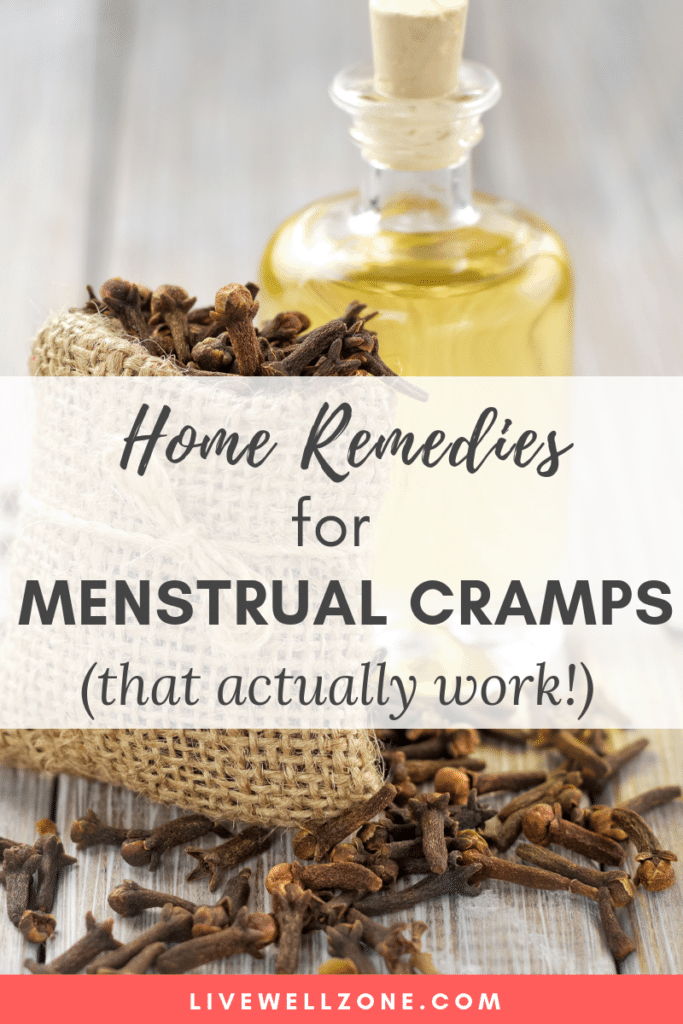
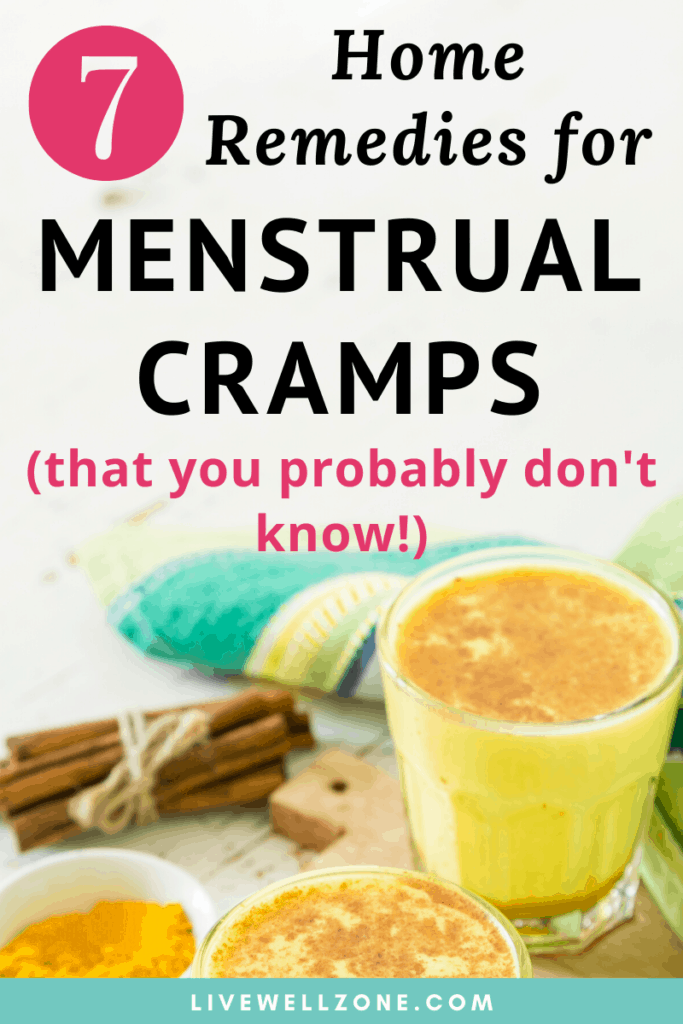
Related Content:
A Complete Guide to Using Vitamin C for Heavy Menstrual Bleeding
10 Herbs for Heavy Menstrual Bleeding (That You Need To Know!)
How To Sleep With Menstrual Cramps: 10 Tips To Get Relief and Feel Rested
Does A Heating Pad Help With Menstrual Cramps? And How To Use It
Do Bananas Help With Menstrual Cramps? Here’s What You Need To Know
Panaway for Menstrual Cramps: Benefits and How To Use
3 Supplements For Female Hormonal Imbalance (you probably don’t know about)
What Essential Oils Are Good for Menstrual Cramps? Here Are The Top 10
Essential Oil Roller Blends for Menstrual Cramps: Best Store Bought and DIY

